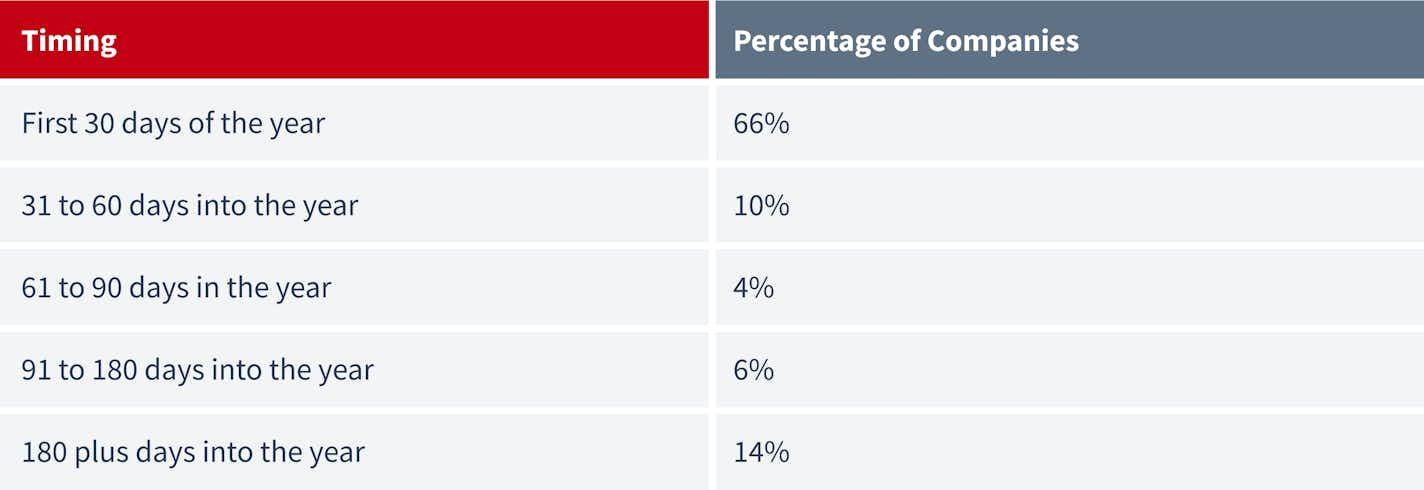Set Your Sales Quotas Early for Better Results

Lots of money is being spent on improving the effectiveness of the sales organization in today’s world. These sales force effectiveness initiatives may range from improved technology, sophisticated training programs, new sales roles, or better product integration. All can be effective, but they also can be expensive, time-consuming, and difficult to implement.
Additionally, it may take a while before they start to produce results. What if there were an easier way to gain more productivity without additional cost or effort? Would you be willing to invest the time and effort?
A lot has been written about the quota-setting process and how to improve its accuracy, but little has been said or written about setting and allocating your quotas earlier to drive better results. Could this be the answer you have been looking for? Could it really be as simple as timely quota setting and communication as the key to better results?
The Problem with Setting Quotas
Many companies invest their time, energy, and resources in the compensation plan design and numerous sales force initiatives for the new fiscal year. In most cases, organizations then leave sales quotas for last, and they become an afterthought or a “plug-in” that links to all the other initiatives.
Often there is a lack of accountability because no organization clearly owns quota setting. In some cases, the functional business organizations with the responsibility to set and administer quotas may have the least visibility to the true market opportunity. Additionally, there may be a lack of attention to the data because it is difficult to capture. As a consequence, targets get set only after HR asks for the numbers so the new compensation plans can be rolled out. Typically, the targets are not communicated until after the fiscal year has started.
On average, only 27% of companies communicated their quotas to the sales teams prior to the start of the fiscal year (see Table 1). (Statistics in this article come from Korn Ferry Sales Force Effectiveness Forums, Industry surveys, and Association meetings.)
Table 1: When Does the Company Set, Allocate and Communicate Quotas?

Can Setting and Communicating Quotas Early Impact Results?
Given that 73% of companies queried do not get their quotas out prior to the fiscal year beginning, how can reps plan their first month, their first quarter, or set their personal goals for the year without knowing their goals? Good sales reps and their managers are the most motivated and positive at the beginning of the year (see Table 2). Why not take advantage of this fact and get them the quotas earlier and take advantage of their motivation?
Table 2: When Are Sales Representatives Most Motivated During the Fiscal Year?

Some may argue that communicating quotas at the start of the year may demotivate reps if they deem the quotas to be too high. Yet, when we asked what message a company sends when it delays quota communication, the results were startling. 41% equate late quotas with internal incompetence, and 55% say the company has something to hide (see Table 3)—not a good way to start a sales cycle.
Table 3: What Message Do Late Quotas Send to the Sales Team?

Increase in Productivity—Can You Count on It?
When asked, 68% of those surveyed said providing reps with their quotas prior to the start of the year has a significant impact on productivity. In fact, production can increase as much as 12% when reps know their quotas ahead of the new sales year.
That same population says that waiting until the 3rd or 4th month to announce quotas can dampen rep productivity by five to six percent respectively. (See Table 4.)
Table 4: How Does the Timing of Quota Communication Impact Productivity?

How to Set Quotas Earlier
Setting quotas early in the sales compensation design process involves a commitment to four actions:
1. Identify the Team
Designate an individual or group as the owner of the quota-setting process. Ideally, quota setting resides in sales operations, but finance or sales also may lead the effort. Assigning responsibility for setting quotas and managing adjustments will enable consistency in management, accountability, and timing.
2. Start Early and Gather the Right Data
Start quota setting when you start the sales compensation process. It is common for sales compensation design to start in the 8th or 9th month of the fiscal year. This is a great time to start the quota process too. The quota team will be in the same development cycle as the compensation team and will be able to work hand-in-hand when strategy and direction are being discussed. Allow at least 12 weeks to develop quotas.
Quotas are only as good as the data behind them, so the more data gathered, the better. To set accurate and effective quotas, first determine marketplace potential and identify the factors that affect sales performance. The key is to gather as much information as possible to understand and make assumptions about customer needs, historical production, sales representatives’ capacity to sell, and corporate expectations.
Organizations need to answer the following questions:

Identify the Approach
There are two ways to proceed when setting quotes: cost of sales or cost of labor.
Cost of sales looks at what it costs to sell the unit, product, or service. Payouts may be based either upon a percentage of volume sold or upon the individual unit, product or service that is sold. Typically, market data is not used, so the calculations are based upon the dollar amount that a company is willing to pay (e.g., 7% on everything a rep sells). The percentage is based upon the anticipated sales amount or the target/quota that is anticipated. This approach is simplistic in that the quota is secondary to the cost of sale. It is a very linear equation in that the more or less a rep sells, the more or less is paid.
Cost of labor is based more on what the industry might pay. Targets are set to stay in line with market pricing. A company is willing to pay a sales rep a certain amount (e.g., $40K in incentive) because that is what the market pays for this job. In this approach, compensation is directly tied to a quota or goal, or the standard industry performance benchmark.
So, which is the best approach? As shown in Figure 1, five factors can influence the quota setting approach: stage of business, sales complexity, a rep’s control over the sale, pay prominence, and company support.

Figure 1: When to Use Cost of Sales vs. Cost of Labor
3. Get It Done
Sales teams believe that getting quotas communicated early makes a difference, and our work with sales organizations in all industries backs that up. Clarity about “the numbers” puts reps on the right path with the right mindset to accomplish sales results. Organizations spend millions on new sales initiatives to increase sales effectiveness but ignore the power of a logical, quota-setting process and timely communication. Make sure reps know their numbers before they start to sell. It really can be that simple. Get the process both started and completed prior to the year starting!
To learn what your sales organization needs to do to stay ahead of the curve in 2020 and beyond, watch the on-demand webcast featuring Korn Ferry and other industry experts.















